

MTI captures strategic thinking of business leaders on COVID-19 and beyond
MTI Consulting, Sri Lanka’s leading specialised management consultancy (and part of the MTI International Network) concluded a pioneering study among 100 of Sri Lanka’s Top CEOs and Directors.
The study is based on one-on-one interviews with Sri Lanka’s business leaders from blue-chip companies, multi-nationals and industry majors, representing a diverse range of industries. It has been supplemented with MTI’s own experience of working on over 650 assignments across 47 countries in the last 23 years. The study and the reporting of the findings will be based on MTI’s Crisis Response Model (as diagrammatically illustrated above):

COVID-19: Expected it?
Nobody expected a lifestyle, livelihood and economic disruption of this magnitude – as a result of a health crisis. A few of the business leaders (with active involvement in capital markets) had expected an economic crisis – given that a market correction was due, a decade after the Global Financial Crisis in 2008 and the Asian Financial Crisis a decade prior to that in 1997. But not a crisis of this magnitude!
Businesses with supply chain exposure to China had sensed some early warning signs. Consequently, they responded in two ways i.e. searching for alternate supply sources (e.g. co-sourcing from the likes of India and Vietnam) and by increasing their inventory levels.
Given that previous health crises such as SARS, MERS, Ebola etc. were confined to a particular geographical region (and that too far away from Sri Lanka), most did not expect a pandemic at their door step!
This global economic (and soon-to-be ecological) correction was coming. COVID-19 is the straw that broke the camel’s back! – MTI
Some businesses started sensing a possible supply chain disruption around January 2020 and had started working on supply chain solutions. Interestingly one business had received an unusually large order for a personal hygiene product in December 2019, but did not read into it!
COVID-19: Prepared for it?
Given that none of the businesses expected a crisis of this magnitude, they were not fully prepared to deal with it. The level of preparedness and the way in which businesses immediately responded, varies across the different type of businesses.
Multi-nationals, larger corporates, banks and telcos – relied on their formalised BCPs (Business Continuity Processes) and were able to execute these. By contrast, the mid-sized local groups relied more on the agility and resilience of their staff, which came in for a high level of commendation and appreciation from their Directors and CEOs.
- MTI Perspective: The agility and resilience of employees, as demonstrated in many previous crises, needs to be lauded and real-life cases published.Impact of it?

Liquidity is the killer!
Businesses with high gearing and extended delays in collecting dues from their customers, were considered to be at the highest risk of closure. Some companies, at the expense of new business  generation, have shifted their entire focus to collections, which under the circumstances would be a prudent approach.
generation, have shifted their entire focus to collections, which under the circumstances would be a prudent approach.
- MTI Perspective: Responsibility for working capital (in most businesses) tends to be fragmented and handled in silos, between Finance, Sales and Supply Chain. In times of crisis, this could be a sub-optimal approach, which therefore needs a holistic approach. Consider the appointment of a full-time / dedicated ‘Working Capital Manager’ (covering the entire value chain) – for the next 6 to 12 months.
The power and pitfalls of Working from Home (WFH)
Operationally, the big revelation for businesses has been the benefits of WFH. As a result of WFH, there have been three realisations for business leaders:
1.Work can be done with less resources – than what current structures / headcounts suggests. n
2. Physical Offices can be smaller in size – considering reduced traffic and shifting to hot-desking
3.Meetings can be done within a shorter duration
Consequently, several CEOs are considering WFH arrangements and virtual meetings – as a regular feature of life after lockdown.
From an employee’s perspective (based on other MTI studies carried out):
- The work load of those WFH during the lockdown has significantly increased..
- The dividing lines between work and family time has got blurred. Employees also have to deal with the additional challenges of a ‘24/7 full house’, the hassles of procuring their life basics and the fear of business sustainability, job losses and pay cuts
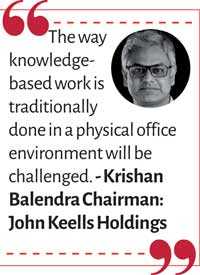
All of this has significantly increased employee stress levels, the consequence of which may not show up on short term performance, but will certainly have a laggard effect.
Of course, the above applies mainly to knowledge-based work in a corporate setting, not forgetting the millions of daily wage earners sweating it out for a meagre pay – who importantly make up the supply chain and demand chain that we profit from.
- MTI Perspective:For WFH to be effective there needs to be an enabling home infrastructure (e.g. a work station, posture-friendly seating, ventilation, lighting and work environment ergonomics). Plus, do not underestimate the importance of in-person socialising on a regular basis
More work can be done with less resources
Arising from their experience of employee work performance during lockdown, nearly half of the CEOs felt that their organisational workload could be done with less resourcing. However, if this period would be representative of ‘normal’ times (to take decisions), this needs to be challenged. Furthermore, even if organisations can do with less staff (which ideally should have been figured out long before COVID-19!), any such decisions now can meet with severe socio-economic consequences. 
- MTI Perspective: In good times, organisations tend to put on ‘fat’ – because when the going is good (with profits being made) it is easier to hide inefficiencies. When hit with a crisis of this magnitude, the ‘slack’ gets exposed. However, instead of making reactive decisions, undertake a ground-zero based scientific capacity assessment – considering the expected scenarios and corresponding strategies.
SMEs, the lifeblood of the economy, at risk
The focus of this study was on large corporates, some of whom depend on SMEs as part of their supply and /or demand eco-system. Some of these CEOs expressed grave concern over the severe impact of the crisis on SMEs, whom they felt may not be able to withstand the blow. Chambers representing the SMEs too have expressed their concerns with regards to the handicaps faced by this sector in accessing bank credit.
- MTI Perspective: Given the socio-political implications of SMEs, some form of relief can only come from a joint effort of the Government, the banks and the corporates who rely on the SMEs for their supply and /or demand chain. With all these 3 stakeholders having their own / other challenges to deal with, it will be a stretch
Competing for a shrunk wallet
As the consumer’s wallet shrinks, they will be forced to make tough choices with their shrunk income, in particular the discretionary income. For example, do they pay their life insurance premium or the car lease rental? Pay the credit card bill on time (and avoid interest) or take that holiday? Businesses too will need to make such tough choices
- MTI Perspective: Businesses need to look beyond traditional industry boundaries, and instead compete with cross-categories for a share of wallet. Which means, the value proposition and go-to-market approaches will need to be aligned to this new reality.
Look beyond core domain capabilities
Businesses that were largely focused on core domain capabilities, as a result of COVID-19, have been challenged to quickly acquire, improve and adapt to adjacent capabilities. For instance, retail chains (thus far focused largely on their core retailing capabilities) have been challenged to improve their logistics and e-commerce capabilities.
- MTI Perspective: Map the entire eco-system that your business serves, from the supply chain to the ‘last mile’ of your demand chain, both ‘brick and mortar’ and virtually.
COVID-19 has reduced carbon emissions, but that’s ‘choking’ the global economy! – MTI
COVID-19: Response to it
Costs: shoot at sight!
Cost cutting (described in many different ways) appears to be an immediate response of almost all (90%) of the businesses.
To about 1/4th of businesses, this appears to be their only ‘master stroke’ to survive the crisis. In such cases, we sensed a ‘kneejerk’ reaction to cost reduction. It was encouraging to see a small minority (about 1/5th) of businesses taking a more strategic approach to cost – by analysing ‘cost drivers’ as the basis of cost decisions.
- MTI Perspective: If businesses had an optimal cost structure (in non-crisis times), then in a crisis you will only need to treat the ‘first-aid’ and ‘emergency’ costs. All other costs should ideally be intact. However, because in ‘good profitable times’ costs are not adequately scrutinised, it has to be painfully chopped off now.
Pay-cuts: symbolic or sustenance?
A diverse range of approaches were adopted by businesses, which includes:
- No choice but to make substantial pay-cuts – to varying degrees across the organisation. Some of them have agreed to pay back these cuts – if and when the business recovers its lost ground..
- Make a symbolic cut (with board and management taking the lead) – even if these businesses can financially withstand the crisis
- Cut off the frills (like bonuses, over-time payments etc.) and pay the basic.
- Take a moral stand that they will not cut employee salaries
- Prudent to wait for another 3 to 6 months (to assess the financial impact on their businesses) and then decide on the approach.
Interestingly, a very small minority (under 10%) had paid their April bonuses, some even paid additional allowances for working during the crisis period.
In cases where CEOs sincerely engaged with their staff to discuss how they should respond to the crisis, there were instances of staff willing to take a voluntary pay-cut.
In companies that did not resort to pay-cuts (and where CEOs demonstrated a genuine effort to protect employee jobs), there was a very high level of employee engagement. In one such case, the employees took it upon themselves to get curfew passes and get their factories opened. In another, Managers performed the role of Security Guards and Janitors in a showroom.
- MTI Perspective: When you involuntarily cut employee remuneration, you are cutting a lot more than money. Understanding the employee psychology and addressing the associated concerns is important. This is also a good time consider a higher % of performance-based variable pay.
Head counts appear to be intact – but for how long?
With the exception of terminating contractual staff, none claimed to have retrenched payroll staff. We were told that as per Sri Lankan labour laws, the retrenchment of payroll staff and reducing their salaries, is technically not possible?
However, in industries where their entire demand chain has come to a grinding halt (like tourism and apparel), some tough decisions may be inevitable.
- MTI Perspective: Head count is a function of business strategy and processes. Therefore, first rationalise and take the ‘slack’ off your strategies and processes, then address the ‘slack’ in the headcount. Otherwise, you may end up with imbalanced cuts in your headcount / structure, which can cripple your operations.
COVID-19 propels the digital agenda!
There has been a quantum increase in digital adoption (in both B2C and B2B), in domains as diverse as supermarkets, higher education, corporate banking, commodity trading – to name some. Almost all the respondents felt that COVID-19 has significantly advanced their digital agenda and created internal pressure to activate their digital initiatives. 
The 126 year old Colombo Tea Auction going online – stands out as a significant achievement and signals what necessity can do!
- MTI Perspective: Businesses must optimise this opportunity to ‘lock-in’ these digital habits – across all stakeholders it deals with.
More M&A activity expected
A heightened level of M&A activity is expected, due to the following reasons:
- A significant number of mid to large businesses will be impacted by significantly reduced revenue (therefore profitability), poor liquidity and /or being highly leveraged.
- Some industries which even prior to COVID-19 were highly fragmented, lacked critical mass and /or capital adequacy e.g. finance companies, insurance?
- Business groups (with access to funding) and HNIs looking for opportunistic low valuations to acquire.
- MTI Perspective: In the current environment, any such M&A activity will lead to serious rationalisations. Further, some of the impacted (e.g. the smaller finance companies) may have very little assets that are worth acquiring. For a global perspective of M&A refer to this latest report by MTI Corporate Finance.
Sincerely engaging stakeholders in a crisis
About 1/4th of the CEOs interviewed had personally taken the lead to meet (in person or virtually) with their two main stakeholders i.e. staff and customer (mostly B2B). They felt it was important to sincerely relate to them in times of distress and did so without expecting any immediate commercial benefit.
However, they were all confident that both staff and customers will remember this gesture for a long time. They also emphasised the need to empathise with the deep-seated anxieties that these stakeholders would be experiencing as a result of this unprecedented crisis.
- MTI Perspective: Such a sincere initiative coming directly from the CEO sends a strong message across the organisation. If finally boils down to leadership values truly lived, not just confined to flashy annual reports!
Maslow’s Hierarchy re-visited!
Almost all B2C businesses interviewed reported significant changes in consumer behavior (within their domains) – covering the full lifecycle of on-boarding, purchasing, payment and importantly usage. Businesses in education, grocery retailing, financial services and telco reported significant changes in consumer behavior, which had forced them to make quantum adaptations fast
Underlying these consumer behavioral changes was the radical change in lifestyle arising from the lockdown. Consumer Needs took preference over Consumer Wants, reflecting in essential foods being prioritised, increased use / spend on broadband etc. 
- MTI Perspective: In this post COVID-19 phase, businesses must continuously track consumer behavior and not assume that lockdown consumer behavior (in extreme conditions) will be the ‘new normal’.
Given the number of people confined to their homes, there is an opportunity to make ‘staycations’ more exciting! – MTI
COVID-19: Learnings
from it?
Virtually a lot can be done!
What was once thought impossible or impractical is now being done virtually – from board meetings to job interviews, from training programs to regional sales meetings. Very interestingly, there is wide spread admission that it is getting things done in a much shorter duration, given the interfaces are far more focused.
However, the need to mix this kind of virtual interface with in-person interfaces (that promote social cohesion) has been expressed.
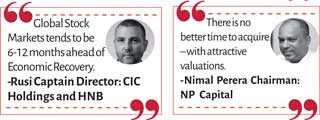
- MTI Perspective: Lock-in these as healthy habits – before we start getting back to old ways!
Re-structure when the going is good
There was admission that for some businesses, it may be too late to re-structure – given the kind of blow these businesses have been dealt with. “Much like the coronavirus, businesses with low immunity are the ones that will suffer most” as articulated by a Non-Executive Director. Therefore, some Business Leaders raised the question if re-structuring should be done in good times?
- MTI Perspective: In the case of the human body, if you exercise regularly, watch your diet and do your annual medical check-ups, you reduce the probability of shocking blows. Similarly, if businesses apply the same disciplines, they can minimise the chances of drastic re-structuring.
Always lean
Almost half of the business leaders recognised the need to have an ‘always-lean’ mode and not just in response to a crisis. They also recognised that this needs to be driven from the Board and C-suite and needs to go beyond corporate rhetoricn
- MTI Perspective:To be ‘always-lean’, in most organisations requires a culture change deeply embedded into the values of the organisation and the leadership. Of course, it needs to be supported with a highly rational and analytics-based methodology. ‘Why?’ and ‘So what?’ are two powerful questions to drive this change.
Greater focus on supply chain management
The following two concepts, considered as best practices, were challenged during the COVID-19 crisis:
- Just-in-Time (JIT)
- Rationalised Supply Chain – in some cases single-sourcing
Businesses that sensed a possible crisis (between 19 November and 20 January) were able to work on alternate sourcing, but for those requiring recurring high volumes it was not adequate.
- MTI Perspective: Develop a risk management framework for supply chain management – that covers the entire eco-system, including the key supply chain to your supply chain (S-1).
Change the lenses with which you see your markets
Most businesses tend to view their market within the boundaries of their industry. This works well in times of stability. 
During the lockdown, businesses were challenged with drastic changes in consumer behavior – the kind they have not encountered before. From online ordering to changed dietary habits, from in-home entertainment to online education.
This, of course, has challenged businesses to re-think their conventional approaches to business practices – from supply chain to ‘last mile’ fulfillment. Businesses also have found themselves competing in cross-categories – in trying to get a share of wallet.
- MTI Perspective: View markets initially from the broader perspective of the economy, the consumer’s lifestyle and livelihood, the broader supply chain and channel. Integrate this into your annual business planning process and challenge your teams to develop strategies linked to this perspective.
Soon the face masks will come off, but businesses will have a lot more to unmask! – MTI
COVID-19: Fixes as a result of it?
Stress Test Business Models
Most corporates claim to have Business Continuity Processes (BCPs) and risk management frameworks in place and effectively practiced. Whilst the larger corporates tend to rely on the processes to ensure contingency management, the mid-tier corporates tend to rely more on the initiative and agility of their management team.
However, in both such cases, their business models were not adequately stress-tested. For instance, what if demand or supply comes to a grinding halt? The very process of asking the question and reflecting on it, better prepares a business for a crisis.
- MTI Perspective:This should be part of the Board agenda and much like BCPs, it should be put into practice on a simulated basis.
Risk manage via focused diversification
Businesses largely confined to one industry, particularly ones that were adversely impacted by COVID-19, expressed a desire for diversification.
If the intent is to diversify by being in very diverse industries, then it needs to be weighed against the dilution of focus by such a move. However, if diversification is by strategic investments, then the above argument is far less applicable. As markets mature and get more specialized, businesses will need to narrow their focus, as could be seen even in emerging markets like India.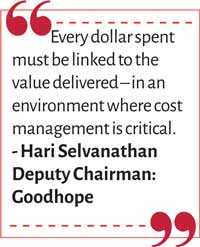
- MTI Perspective: Before moving across industries, map your entire domain eco-system (end to end), including all the converging domains, for opportunities
Challenge Marketing Spends for ROI
Consumer lifestyles, buying behaviors and usage habits have all undergone significant change. There is also a somber mood that prevails among consumers – given multiple life challenges that they are grappling with.
Given the above, the A&P (Advertising and Promotional) strategies and practices of most businesses have been altered in response. Much like in any crisis, A&P has been on top of the list of ‘cuts’, this time it is likely to be deeper and for longer!
Interestingly on this occasion, several CEOs have raised serious questions on all types of marketing spend, the main ones being:
- Are we over-spending on good timesn
- Are we holding marketing responsible for ROI – like we do for any such ‘big ticket’ items?
- MTI Perspective: Instead of treating A&P, Sales Force and Channel in silos, focus on demand generation (the end result). In the case of most e-commerce businesses, the dividing lines between the 3 ‘means’ has largely converged. Challenge the notion of a routine annual A&P budget – because this financial year-based spending has no link to the customer acquisition, retention and optimisation cycle.
Critical KPIs that need greater focus
Two types of businesses that have been most impacted by the crisis are:
- Those with very high fixed costs – with relatively weak links to bottom-line performance.
- Those, despite healthy profitability (in conventional terms), have very weak free cash flows.
- MTI Perspective: Three Critical KPIs to be monitored regularly, which should ideally be part of the CEOs’ personal dashboard:
- Fixed costs – as a % of total costs
- Free cash flow based break-even
- The use of ‘Performance-based pay’ and ‘pay per use’ principles can help achieve healthily outcomes on the above KPIs
Self ‘insurance’ for high impact crisis
Some large businesses have been criticised for pay cuts, considering mass-scale retrenchment and even asking the Government for a bail out. The argument being, you make so much money for so long, surely can’t you tide over a few months of paying at least the basic salary?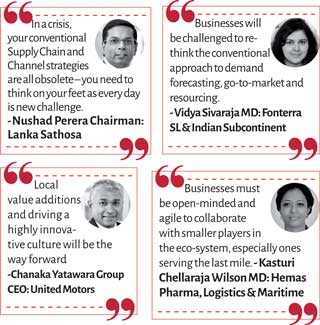
Of course, this is a one-sided, outside-in view. Therefore, it is also important to understand the views and circumstances of these large companies. The intent of raising this point, coming from a handful of respondents, is not to criticise these large companies, but to look for a future solution.
- MTI Perspective: Consider a co-contributing internal fund – that acts as an insurance for income loss – in case of such a high impact crisis. If unutilised, it could be cashed-in at the point of resignation.
Boards needs to ask the hard questions, more often
Board Directors, interviewed as part of this study, felt the need for greater focus on business model and strategic risks. Some acknowledged that matters relating to governance and compliance tends to take up most of their energy
- MTI Perspective: : Consider two types of board meetings, one for routine performance monitoring, governance and compliance and the other for business model and strategic risks (including the related performance aspects). Develop a specific checklist for the latter, requiring each board member to individually assess the business model and strategic risks and how well the business is mitigating these.
Experiment with flexible working models
WFH on a full-time basis, as pointed out earlier in the study, may not be suitable for all. Neither is physically commuting to office daily.
Most corporate offices are located in Colombo, where real estate prices are the highest. A significant % of staff tend to live in the outskirts and spend considerable time commuting to office.
As pointed out by an always future proofing CEO: Consider setting up (or ideally on an out-sourced basis) lean office space in the outskirts of Colombo – which can significantly reduce travel time and still provide employees a conducive working environment that can be alternated with WFH
When confronted with a crisis, there is a choice to make.
Be a cry-sis or be a try-sis – MTI
- MTI Perspective: Along with a lean culture, driving the habits of hot-desking and being paperless will enable the new work arrangement above.
COVID-19: National Response to it?
Government appreciated for its decisive handling of the crisis
The effective handling of the pandemic by the Government (via its military and healthcare eco-system) came in for commendation by many Business Leaders. Of course, there were the cynics as well! In terms of enabling operational logistics for factories to operate, businesses did encounter ‘road blocks’ early on, which appears to have been subsequently better enabled.
Whilst a few kept on complaining and criticizing the state of affairs, the smarter businesses found practical ways to work around it and get their operations off the ground. In the words of an export-industry CEO “these are unusual times, so you need to find unusual ways to survive and thrive!”
With regards to the gradual easing of the lockdown, the majority of the Business Leaders felt it was a prudent decision – considering the impact it has on both the livelihood of the masses and the continuity of their own business operations. Of course, there are a few who argue that we should wait until ‘Corona’ has been banished for good!
In the words of a Group CEO “In life we have to make choices. Each of these choices has an opportunity cost and risk attached to it. These are calculated judgement calls that we need to make. Only when you execute your decisions will you know how it works! We need to learn from each of these experiences and sharpen our response mechanism.”
MTI Perspective: The Government should consider digital-optimization of the full crisis lifecycle, from early warning systems to police passes to contact tracing.
Import Restrictions is an emergency treatment – not a protectionist privilege
The restriction of imports is considered a necessary short-term measure and it is hoped that local industries will see this as an opportunity to ‘up their game’ and not consider it as a protectionist privilege afforded.
This policy needs to be reviewed in the context of globalization and the principle of comparative advantage. The rising wave of economic nationalism and protectionism needs to be addressed cautiously and prudently.
MTI Perspective: Policy making and economic strategizing needs to be kept flexible and fluid – given that those living today have not handled a crisis of this magnitude.
Moratoriums are largely funded by depositors
The financial services sector is gravely concerned about the impact of the moratorium on their liquidity positions. They point out that approximately 85% of the money they lend is that of deposit holders (including senior citizens) – whose interest they feel is not getting due attention.
Due to the impact of the moratorium on liquidity, some of the smaller finance companies (whose financial position was weak pre COVID-19), may face ‘life threatening’ conditions! This could create panic among depositors and threaten even the relatively larger institutions.
The moratorium also delays the process of figuring out the impact of the crisis on the ‘going concern’ of the borrowers. This could potentially result in a massive spike in non-performing assets when the moratorium ends, the knock-on effect of which could be disastrous!
MTI Perspective: Consolidation of the NBFI sector (possibly even the Banking Sector?) needs consideration. Banks need to ‘innovate’ ways to sense the financial health of their clients during the moratorium and not wait until it ends for ‘surprises’! Consider incentives to encourage these clients to pay at least part of their dues during the Moratorium period?
COVID-19: National response
to it?
Government appreciated for its decisive handling of the crisis
The effective handling of the pandemic by the Government (via its military and healthcare eco-system) came in for commendation by many business leaders. Of course, there were the cynics as well! In terms of enabling operational logistics for factories to operate, businesses did encounter ‘road blocks’ early on, which appears to have been subsequently better enabled.
Whilst a few kept on complaining and criticising the state of affairs, the smarter businesses found practical ways to work around it and get their operations off the ground. In the words of an export-industry CEO “these are unusual times, so you need to find unusual ways to survive and thrive!”
With regards to the gradual easing of the lockdown, the majority of the business leaders felt it was a prudent decision – considering the impact it has on both the livelihood of the masses and the continuity of their own business operations. Of course, there are a few who argue that we should wait until ‘corona’ has been banished for good. 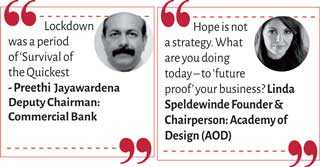
In the words of a Group CEO: “In life we have to make choices. Each of these choices has an opportunity cost and risk attached to it. These are calculated judgement calls that we need to make. Only when you execute your decisions will you know how it works! We need to learn from each of these experiences and sharpen our response mechanism.”
- MTI Perspective: The Government should consider digital-optimisation of the full crisis lifecycle, from early warning systems to police passes to contact tracing.
Import restrictions is an emergency treatment – not a protectionist privilege
The restriction of imports is considered a necessary short-term measure and it is hoped that local industries will see this as an opportunity to ‘up their game’ and not consider it as a protectionist privilege afforded.
This policy needs to be reviewed in the context of globalisation and the principle of comparative advantage. The rising wave of economic nationalism and protectionism needs to be addressed cautiously and prudently
- MTI Perspective: Policy making and economic strategising needs to be kept flexible and fluid – given that those living today have not handled a crisis of this magnitude.
Moratoriums are largely funded by depositors
The financial services sector is gravely concerned about the impact of the moratorium on their liquidity positions. They point out that approximately 85% of the money they lend is that of deposit holders (including senior citizens) – whose interest they feel is not getting due attention.
Due to the impact of the moratorium on liquidity, some of the smaller finance companies (whose financial position was weak pre COVID-19), may face ‘life threatening’ conditions! This could create panic among depositors and threaten even the relatively larger institutions
The moratorium also delays the process of figuring out the impact of the crisis on the ‘going concern’ of the borrowers. This could potentially result in a massive spike in non-performing assets when the moratorium ends, the knock-on effect of which could be disastrous!
- MTI Perspective:Consolidation of the NBFI sector (possibly even the banking sector?) needs consideration. Banks need to ‘innovate’ ways to sense the financial health of their clients during the moratorium and not wait until it ends for ‘surprises’! Consider incentives to encourage these clients to pay at least part of their dues during the moratorium period?
COVID-19: Happen again
– will it?
In the near term, the focus of Governments and businesses (around the world) will be on coming out of the crisis, effectively ‘damage control’.
- MTI Perspective: Instead, it is argued that we should prepare for a ‘new normal’ – expecting more ‘invisible enemies’, more frequently and perhaps more damaging? Here’s why:
- The global population which was only 1.65 billion in 1900, today stands at 7.7 billion and expected to grow to 11.2 billion by 2100.
- This means the need for more space to live, more land to produce food, more space to travel – all this additional space is coming from forests and jungles (which is not meant for humans!).
- The prosperity of our economies, our enterprises and our employees are all addictively dependent on consuming more and more.
- This in turn means more space for more production and more pollution.
- The side-effects of all of the above is why we need to be always ready for the next crisis!
Bird flu, Swine Flu, Mad Cow Disease, COVID-19. See a common thread? – MTI
Ready for the next crisis?
Imagine if ‘COVID-20’ attacks the World Wide Web? It’s an ‘inconvenient thought’, but worth thinking about!
Global Financial Crisis was a ‘circuit breaker’ caused by the banks.
Currently we are experiencing a ‘circuit breaker’ caused by a virus.
Imagine when Mother Nature’s ‘circuit breaker’ is applied on
us! – MTI
About MTI Consulting
MTI Consulting (www.mtiworldwide.com) is an internationally-networked, boutique management consultancy, enabling our clients to ‘Analyse > Strategise > Realise’ effective outcomes. Our practices include Strategy, Business Operations, Corporate Finance, HRM, Go-to-Market and Digital and Analytics.
Since its inception in 1997, MTI has worked on assignments in over 47 countries, covering a diverse range of clients, brands, industries and challenges. MTI is powered by a pool of internationally experienced Strategy Consultants and Analysts, augmented by a panel of Specialists – by Industry, Function and Geo-Domains and like-minded boutique consultancy relationships in over 30 countries
